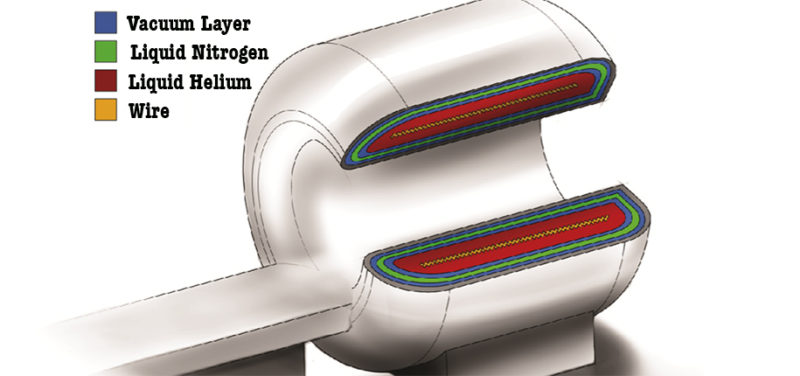
Here at Cincinnati Children’s, we have around six MR scanners in our Radiology department. Have you ever wondered what’s inside of an MRI scanner and why it makes those weird noises? Well, did you know that liquid helium is one of the major components inside of the MRI scanner?
When we think of helium, we think of birthday balloons, not medical imaging. However, only a small percentage of helium is used to fill balloons. The largest single use of helium, 28% of all helium, is used to keep things very cold. Liquid helium boils at a temperature of 4.7 Kelvin, or -452.1 degrees F! Anything covered in liquid helium stays at a constant 4.7 Kelvin. When some materials are cooled to this extremely low temperature, they conduct electricity with no resistance and are known as superconductors. Electrical current running through a wire creates a magnetic field. Superconducting wires can be used to produce a larger uniform magnetic field than non-superconducting wires. A large uniform magnetic field is necessary to make images with Magnetic Resonance Imaging (MRI).
The magnetic field in an MRI machine is very uniform and is actually 300-600 times larger than earth’s magnetic field! This magnetic field is generated by a large coil of superconducting wire, which is bathed in liquid helium to keep it cold and maintain superconductivity. Each MRI magnet has approximately 1,700 L of liquid helium, which is 1,190,000L when converted to a gas. That is enough to fill 84,000 standard helium balloons with a lifting capacity of 1,190 Kg (17 average men).
The helium in MRI machines is insulated by a vacuum chamber. Some have an outer layer of liquid nitrogen and an additional vacuum chamber, all to decrease the amount of helium boil off. But some helium boils off anyway. The high-pitched chirping noise you hear when you are in the room with an MRI scanner is a helium condenser re-liquefying the helium that is continually boiling off so we don’t have to refill the scanner’s helium tank. So next time you think about an MRI machine don’t forget about the helium!
 Illustration: Cutout of MR Scanner
Illustration: Cutout of MR Scanner
Contributed by Dr. Aaron McAllister and edited by Glenn Miñano, BFA.
